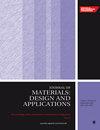通过循环测试对复合材料的损伤演变进行实验测定和预测
IF 2.2
4区 材料科学
Q3 MATERIALS SCIENCE, MULTIDISCIPLINARY
Proceedings of the Institution of Mechanical Engineers, Part L: Journal of Materials: Design and Applications
Pub Date : 2024-05-28
DOI:10.1177/14644207241242739
引用次数: 0
摘要
本研究介绍了一种在连续损伤力学框架内利用准静态循环测试获取和预测损伤演变规律的新方法。为此,进行了一系列全面的表征和参数识别测试。碳-环氧试样采用丝状缠绕技术制造,并使用万能试验机对这些层压板进行测试。所有实验都采用了数字图像相关技术来捕捉应变场,并介绍了一种利用组合加载压缩装置获得机械性能的替代方法。材料特性确定后,进行了循环试验,包括[公式:见正文]、[公式:见正文]和[公式:见正文]拉伸试验以及剪切 V 形缺口试验。这些试验旨在确定纯应力状态和耦合应力状态两种条件下的损伤演变规律。通过这些试验,获得了损伤开始值和阈值,并用这些值定义了四个新参数。这些参数允许对任何任意方向的退化关系进行估计,而不需要额外的测试。在横向拉伸和平面剪切应力域的正向范围内,对这种方法进行了概念验证测试。获得的结果很有希望,证明可以将其推广到其他失效机制中。在承认其局限性的同时,这一新方法在纤维增强复合材料的渐进失效分析中具有实施潜力,有可能与既定的失效标准和计算工具(主要是有限元法领域)相结合。本文章由计算机程序翻译,如有差异,请以英文原文为准。
On the experimental determination and prediction of damage evolution in composites via cyclic testing
This study introduces a novel approach to obtaining and predicting damage evolution laws using quasi-static cyclic testing within the framework of continuum damage mechanics. To achieve this, a comprehensive set of characterization and parameter identification tests was performed. Carbon-epoxy specimens were manufactured using the filament-winding technique, and these laminates were tested using a universal testing machine. Digital image correlation was employed in all experiments to capture strain fields, and an alternative method utilizing the combined loading compression device is presented to obtain mechanical properties. Once the material was characterized, cyclic tests were conducted, including [Formula: see text], [Formula: see text], and [Formula: see text] tensile tests, and shear v-notch tests. These aim to determine damage evolution laws for both conditions, pure and coupled stress states. From these tests, values for damage onset and threshold were obtained and used to define four new parameters. These parameters permit the estimation of degradation relationships for any arbitrary orientation without requiring additional tests. This approach was tested as the proof-of-concept within the positive range of transverse tension and in-plane shear stress domain. The obtained results are promising, justifying its extension to other failure mechanisms. While acknowledging its limitations, this new approach holds potential for implementation in the analysis of progressive failure in fiber-reinforced composite materials, possibly in conjunction with established failure criteria and computational tools, mainly in the finite element method domain.
求助全文
通过发布文献求助,成功后即可免费获取论文全文。
去求助
来源期刊

CiteScore
4.70
自引率
8.30%
发文量
166
审稿时长
3 months
期刊介绍:
The Journal of Materials: Design and Applications covers the usage and design of materials for application in an engineering context. The materials covered include metals, ceramics, and composites, as well as engineering polymers.
"The Journal of Materials Design and Applications is dedicated to publishing papers of the highest quality, in a timely fashion, covering a variety of important areas in materials technology. The Journal''s publishers have a wealth of publishing expertise and ensure that authors are given exemplary service. Every attention is given to publishing the papers as quickly as possible. The Journal has an excellent international reputation, with a corresponding international Editorial Board from a large number of different materials areas and disciplines advising the Editor." Professor Bill Banks - University of Strathclyde, UK
This journal is a member of the Committee on Publication Ethics (COPE).
 求助内容:
求助内容: 应助结果提醒方式:
应助结果提醒方式:


